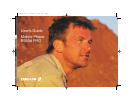Not for commercial use
– Ericsson Inc.
Guidelines for Safe and Efficient Use 3
independent research by and recommendations of Wire-
less Technology Research.
Persons with pacemakers:
• Should ALWAYS keep the phone more than six
inches from their pacemaker when the phone is
turned ON.
• Should not carry the phone in a breast pocket.
• Should use the ear opposite the pacemaker to mini-
mize the potential for interference.
• If you have any reason to suspect that interference is
taking place, turn your phone OFF immediately.
Hearing Aids
Some digital wireless phones may interfere with some
hearing aids. In the event of such interference, you may
want to consult your service provider (or call the cus-
tomer service line to discuss alternatives).
Other Medical Devices
If you use any other personal medical device, consult the
manufacturer of your device to determine if it is ade-
quately shielded from external RF energy. Your physi-
cian may be able to assist you in obtaining this
information.
Turn your phone OFF in health care facilities when any
regulations posted in these areas instruct you to do so.
Hospitals or health care facilities may be using equip-
ment that could be sensitive to external RF energy.
Vehicles
RF signals may affect improperly installed or inade-
quately shielded electronic systems in motor vehicles.
Check with the manufacturer or its representative
regarding your vehicle. You should also consult the man-
ufacturer of any equipment that has been added to your
vehicle.
Posted Facilities
Turn your phone OFF in any facility where posted
notices so require.
Aircraft
FCC regulations prohibit using your phone while in the
air. Switch OFF your phone before boarding an aircraft.
Blasting Areas
To avoid interfering with blasting operations, turn your
phone OFF when in a “blasting area” or in areas posted:
“Turn off two-way radio.” Obey all signs and instruc-
tions.
Potentially Explosive Atmospheres
Turn your phone OFF when in any area with a poten-
tially explosive atmosphere and obey all signs and
instructions. Sparks in such areas could cause an explo-
sion or fire resulting in bodily injury or even death.
Areas with a potentially explosive atmosphere are often
but not always clearly marked. They include fueling
areas such as gasoline stations; below deck on boats; fuel
Ditto Lornetta.book Page 3 Thursday, July 13, 2000 3:55 PM


















